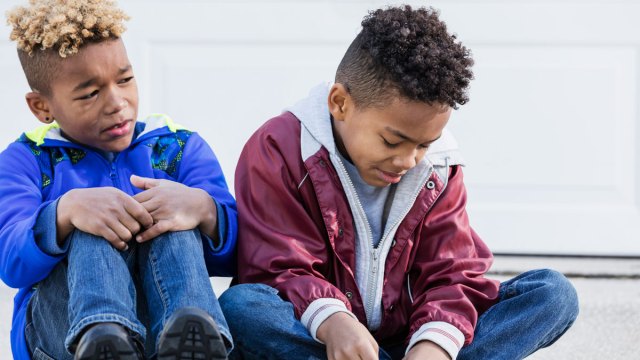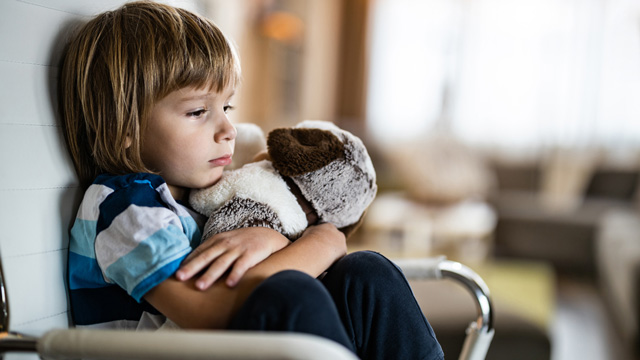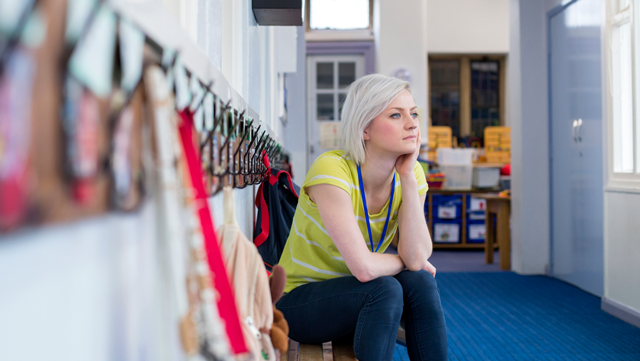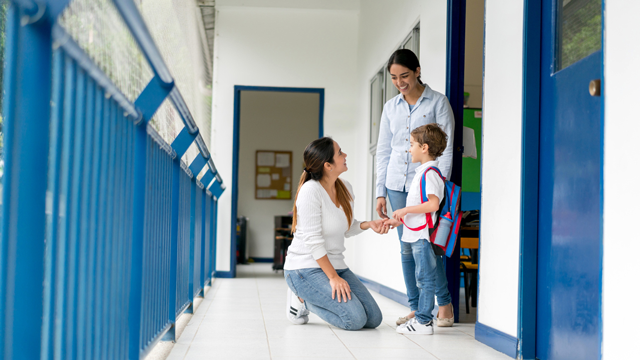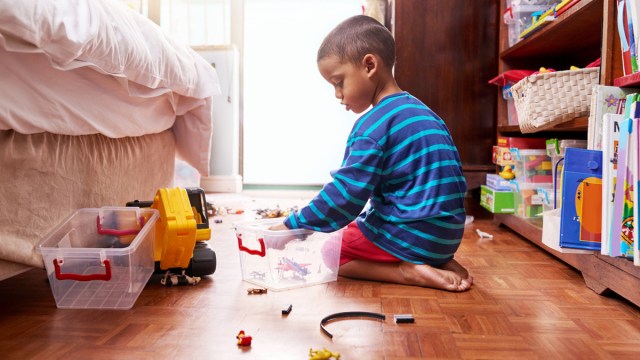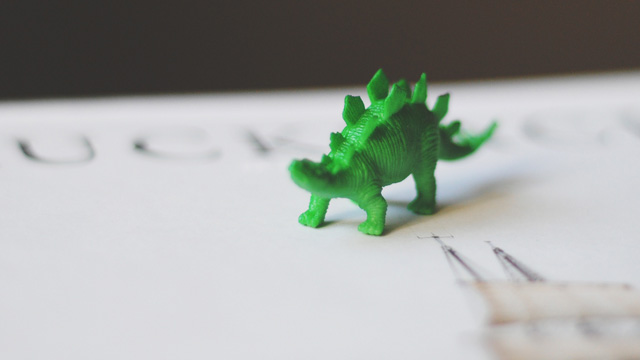We want our kids to be liked, so when they’re not picked for a team or their BFF suddenly switches to another friend group, it’s almost (but not) harder for us than for our littles. After all, we want to help them build self-confidence and self-esteem, and when our kids feel left out, we’re stuck trying to figure out what to do.
“When a parent feels that their kid has been slighted, a lot of times they want to fix it right away, but they need to learn to pause,” says Katie Hurley, a child and adolescent psychotherapist and author of the award-winning book No More Mean Girls: The Secret to Raising Strong, Confident, and Compassionate Girls.
That’s right, Mom and Dad. Our kids have got this—at least, most of the time. Read on to learn how to build self-confidence and self-esteem in kids when they feel left out and when you should (and shouldn’t) get involved.
First of all: Don’t tell your kids, “It’s not a big deal.”
Even at the most “inclusive” schools, your child’s school day holds a veritable minefield of opportunities to be excluded. A friend is sitting at a different lunch table? That’s a blow! A BFF chooses to play kickball instead of the usual recess chat session? Ouch! These moments might seem trivial to you, but these everyday moments are loaded with meaning for kids.
“Lunch is always a hard time because sometimes lunch tables change without warning. If your child is used to sitting with a certain group of kids one day and then someone suddenly switches to another table, it can feel really hurtful,” says Hurley. So resist the urge to tell your kid not to worry, and just empathize.
Empathize—and resist the urge to fix it.
If hearing that another child ignored your kid on the playground makes you want to go full Mama Bear, hold up. Letting your kids deal with their dramas may not be so bad. Hurley, who also wrote The Happy Kid Handbook: How to Raise Joyful Children in a Stressful World, explains, “You don’t become resilient if you don’t go through hard things. Building distress tolerance is important.” Some things you can say:
- It’s hard to feel left out.
- I get it.
- It looks like that really hurts.
- I would feel lonely, too.
- That sounds really hard.
Don’t try to rationalize (at least, not yet).
If your kid just found out they weren’t invited to a sleepover, now’s not the time to tell them how most parents can’t handle a soccer team-sized gaggle of kids on their living room floor. Let your child feel all the feelings and save the rationalizing for later.
“The child is feeling hurt and rejected, so your rationalizing and making it better is not addressing their hurt. Respecting where they are with feeling hurt is a top priority,” explains Jennifer Miller, founder of Confident Parents Confident Kids, a website based on Miller’s book of the same name.
Once your child has expressed their feelings and seems out of the red zone, that’s when you can try to give them an explanation.
Then, shift into problem-solving.
Once your child has felt all the big feelings and seems calm, try to shift the conversation to the future. If the problem is not having someone to play with at recess, for instance, talk about some easy ways they can learn to approach a group (this LifeHacker article has some good tips) or what other options there may be during that time frame (some schools allow kids to go to the library).
Talk about “Friendship Seasons.”
If your child’s best friend seems to be suddenly pulling away, remind your child that it doesn’t mean it’s forever. Parents should tell their kids that friendships may come and go like “seasons.”
“Sometimes friendships feel like summer all the time—you’re playing every day and everything is great—and then all of a sudden it’s winter,” Hurley said. “You can say something like, ‘It sounds like it’s time for a pause on this friendship.’”
Make a friendship map.
Hurley suggests that parents have kids draw a map of all the places they go–including sports teams, religious school, and extracurricular classes—and name all the kids who are their friends in those places. This helps them realize that while they may have their core besties at school, they’ve got buddies in other places, too.
Don’t make the other person the bad guy.
While it may offer consolation to say things like, “He’s just jealous” or to dismiss the offender as being “mean” or a “bully,” putting down the person who is doing the excluding only teaches your kid how to exclude, too! It also zaps any opportunity for your child to come up with solutions to the problem.
If the issue is one person dictating the games at recess, for instance, calling that friend “bossy” doesn’t make it better; but teaching your child how to develop—and enact—a turn-taking system does.
Don’t compliment our kids to make them feel better.
We’re parents; it’s natural to look for a way to build kids’ self-confidence and self-esteem when they’re down. But while our first reaction may be to praise them (“But you were the best one there!” “You’ll get it next time!” “I still love you!”), this may not always work when our kids are feeling left out.
“When we say something back to them to make them feel better . . . it actually lowers their self-confidence,” clinical psychologist Dr. Becky Kennedy said in this viral TikTok video. “Confidence isn’t feeling good about yourself; confidence is self-trust.” Instead, she said parents should say things like:
- “I’m so glad you’re sharing that with me.”
- “Tell me more.”
- “Keep going.”
Kennedy said, “When we show our kids that we’re not scared of their experiences, they learn not to be scared of those same experiences.”
Know when it’s FOMO.
Nobody can go to every event, party, and sports game happening on any given Saturday—despite how some kids may feel. So if your kid breaks down when they find out something is happening without them, try to remind them of all the activities and events they are doing.
Talk about inclusion.
Now that your child knows what it feels like to be left out, you’ve got the perfect opportunity to talk to them about how it may feel for others. Don’t do this when your child is upset; instead, keep it in your back pocket to bring up later. “Kids should know that sometimes they will be excluded and sometimes they will be the excluder. That can begin to open up conversations about being inclusive,” says Hurley.
Realize that there’s a silver lining.
Sometimes, being left out can be a powerful motivator. Not making the soccer team may push an aspiring soccer player to practice more; conversely, not getting a part in the school play may make a child realize they don’t like acting that much anyway.
Even more importantly, feeling left out is a perfect opportunity to build empathy. “It really hurts to be left out, to feel rejected, but it allows kids to begin to empathize and have compassion for others who are marginalized and to learn how to be an inclusive child which is not automatic,” states Miller.
Know when something more is going on.
If your child is perpetually feeling left out, you might want to do a little digging to figure out what might be going on. “A lot of times the kids who are always left out are the ones who keep to themselves or who hang back and wait to be asked,” Miller says. Those kids may need a little more coaching to step into things on their own. If you know they want to be in the talent show, for instance, help them find a group long before the week of the show.
Of course, if the issue is bullying or a child feeling excluded from all social events, you may want to talk to a teacher or the school psychologist or find a therapist to help your child. “Deliberately being left out because kids are being unkind, that’s never a good experience. That’s a different conversation,” Hurley says.
Related Story: 7 Things You Can Do If Your Child is Being Bullied
If you buy something from the links in this article, we may earn affiliate commission or compensation. Prices and availability reflect the time of publication.







